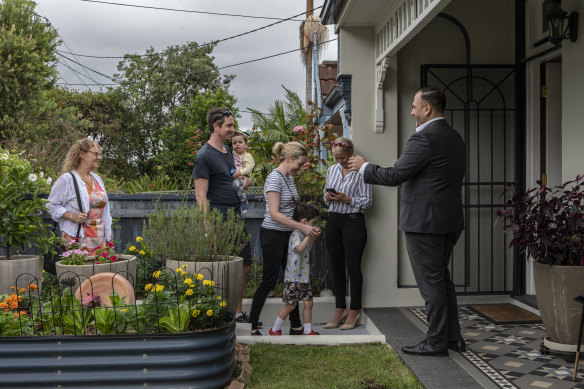This was published 1 year ago
Thought it was hard enough to buy a home? It just got worse
Housing affordability got worse for renters, mortgage payers and prospective home buyers in 2023, and there’s little relief in sight for next year.
It would take 10 years for the median household to save up a 20 per cent deposit on the median Australian home, after briefly falling below the double-digit threshold earlier this year, the ANZ CoreLogic Housing Affordability Report for November found.

Housing affordability got worse this year.Credit: Flavio Brancaleone
Home buyers face the challenge of rising home values despite rising interest rates that would traditionally push home prices lower, the report found, as property prices started to recover from their downturn amid population growth, a lack of homes for sale, tight rental markets and expectations the cash rate may be close to its peak.
The mortgage burden has also risen as interest rates have lifted from their record lows. A typical household would need to spend 46.2 per cent of their income to pay the mortgage on a typical Australian home, assuming they had a 20 per cent deposit, the research found.
Potential buyers can borrow less as interest rates rise, widening the gap between how much houses cost and how much buyers can afford to pay without being in mortgage stress.
The median Australian home value is about $741,000, across cities and including houses and units, even though that figure may look cheap to residents of the largest cities. But the median household wanting to avoid mortgage stress would have a budget at auction of just $479,000.
Meanwhile, rising rents make it harder to save a deposit. Advertised rent values are up 28.4 per cent since the pandemic began, the report found.
“There’s probably more challenges than ever for first home buyers trying to get into the market,” CoreLogic head of Australian research Eliza Owen said.
“The serviceability issue in particular is showing a real departure from the kind of dwelling value that would be affordable for people across Australia versus what values actually are.”
Owen said low-income households had been hit hardest as a higher portion of their income would be dedicated to rent, while their borrowing capacity would be affected if they tried to get a mortgage without family help or an inheritance.
“If you don’t own housing already, it’s very difficult for incomes to keep pace with the movement of values, particularly for houses,” she said. Recent buyers were also affected by rising mortgage costs.
She said the figures pointed to a worsening in inequality, because home buyers would need a higher income to service a mortgage or greater wealth to reduce the size of their debt.
“The median dwelling value, for the median income, is not really serviceable with a 20 per cent deposit at the moment,” she said.
“You either need a greater deposit or you need a higher income or property prices need to drop pretty drastically in order to become affordable, from a mortgage perspective.”
Those on moderate incomes would probably target units or cheaper areas, Owen said, adding Australians had also been responding to the affordability issues by reducing discretionary spending, working more hours and saving less to put money into their mortgage. She also expects household sizes to increase to deal with higher rents.
Next year, she noted, ANZ expects a decline in interest rates later in the year but said it would have little benefit to median households hoping to buy a median dwelling. Home value growth has also been starting to soften in Sydney and Melbourne, but a cyclical decline was not the same as a price fall that would improve affordability, she said.
ANZ senior economist Adelaide Timbrell said renters were particularly vulnerable. Home owners dealing with large increases in their mortgage were also feeling the squeeze, but they may have more options such as refinancing, going to interest-only payments for a time or even pausing payments under hardship provisions.
“When you’re a renter, you just don’t have access to those avenues of flexibility,” she said. “You also don’t have any equity.”
Households are spending less on discretionary items, and the household savings rate is lower than it has been over the past 12 years, Timbrell said.
She said worsened housing affordability kept households in the rental market and delayed them from buying and building wealth, dividing those who own assets and those who do not.
She expects housing prices will continue to rise next year and affordability will be just as bad as it is now.
“We’re not seeing any reason to think there’s going to be a turnaround in housing affordability any time soon.”